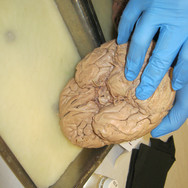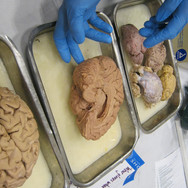Career Close-Up: Neuroscientist
- Ruqaiyah and Afnaan Damrah
- Apr 10, 2017
- 6 min read

Are you excited by science and discovery? Do you enjoy solving problems? Are you creative, patient, and determined? Are you good at working with others and communicating your ideas through writing and speaking? If so, you may want to consider a career in neuroscience! A neuroscientist is a specific kind of medical scientist, and it is one of the most exciting and promising careers out there. Not many kids and teens realize that they are capable or smart enough to become a scientist, so we want to show you that you can! We’ll walk you through what a neuroscientist is and give you some tips and information for following this career path!
There are many types of medical scientists, and they all specialize in different areas. Neuroscientists study the brain and nervous system and try to understand how it works and how they can cure diseases. They work on teams with other researchers and publish and present their findings. They often work in laboratories, offices, and hospitals, and they may also treat patients. They can make about $82,000 salary a year.
To be a neuroscientist, you’ll need very strong communication and writing skills. It’s important to know how to work with others and also how to work independently. You have to be able to pay attention to details and do repetitive tasks. You will need to be patient and persistent.
If you plan to become a neuroscientist, you should focus on math and science (especially biology and chemistry) in high school. You will also need to develop your writing and speech skills. After high school, you will probably need a Ph.D. in neuroscience to pursue research, and starting out with a degree in biochemistry, biology, or chemistry is a good idea.
Being a neuroscientist can be incredibly challenging and frustrating at times. Before beginning research, scientists must present their ideas in order to get money to fund their projects, but many times they don’t get the money they need. Projects can take years to complete and will often have results that they don’t want. This isn’t to say that being a neuroscientist doesn’t have its rewards. The knowledge that they are making a difference in human health is reward enough for many, and making discoveries, however long it takes, is one of the best feelings in the world.
We recently had an up-close look at what neuroscientists really do. On March 11th, Oregon Health and Science University sponsored a brain fair at OMSI. Dozens of neuroscientists, professionals, students, and volunteers spent their Saturday teaching the public about their work in improving human health. Two of us had the opportunity to attend this event and talk to some professionals, and we were very impressed and inspired. We interviewed an education coordinator and a neuroscientist and asked them some questions about their work and their advice for students interested in this field.
The Oregon National Primate Research Center is one of seven in the U.S. and is home to some of the country’s most cutting-edge and innovative scientific programs in biomedical research. The research here focuses on four aspects: neuroscience (the study of the brain), the immune system, the reproductive and developmental systems, and energy balance (which includes research that focus on obesity, diabetes, and cardiovascular health).
We talked with Diana Gordon, the Education and Outreach Coordinator of the ONPRC. She is very passionate about her job and loves educating people. “My favorite part of my job is interacting with the public and helping them to understand why we do biomedical research and why we use animals,” she said. A lot of people feel that it isn’t ethical to perform research on animals. However, Diana Gordon believes that the benefits of animal research touch everyone on so many different levels, and she enjoys teaching people how the primates are taken care of and why animal research is absolutely necessary. “There are ethics of using animals for research,” she said, “but there are also ethics of not using animals. If we’re not going to use animals for research, I can’t just tell someone with Alzheimer’s, ‘sorry, we can’t find a cure…’ I enjoy helping people connect the dots and understand why this is important.”
We asked her what advice she has for students who want to enter the research field. “You should definitely get an internship,” she said, “and if you’re in college, approach a professor and ask to help out in the lab… Even say, ‘I’ll just wash dishes.’” Starting out in any small way will open doors to other opportunities.
“You have to be creative in order to ask good questions,” she explained. “You have to be able to pitch those questions, so you need the ability to speak; speech and debate classes would be a good idea. You also have to be able to write and articulate your ideas, so subjects like English, literature, writing would be good. You need to understand how to manage a budget, especially if you have your own lab… you have to hire people, fire people… There’s no subject [or skill] you don’t need,” she said, laughing. “I can’t say to just study science! Sorry!”
Others prefer to make their contribution to science by working in a lab rather than interacting with the public.
Dr. Philip Copenhaver is a professor of cell biology and a developmental neuroscientist at OHSU. He is very interested in cell migration, which is when neurons travel great distances to find their correct location. However, when something in that process goes wrong, complications could develop. His research focuses on the processes that control neuron migration so that he can figure out how to stop those complications. The problem is that mammalian brains can be quite hard to study; that’s why he uses “model systems.” He studies the nervous systems of caterpillars and applies this knowledge to the human nervous system.
Dr. Copenhaver is extremely passionate about his research, and he excitedly explained to us the aspects of his work. He said that being a scientist is hard and frustrating at most times; experiments fail, grants are not awarded, data doesn’t match up, experiments have to be redone dozens of times. “Scientists are the biggest optimists,” he said. “Science usually doesn’t work… Most of the time we’re doing experiments to prove that we’re wrong.” He truly believes that it’s worth it, though. “The coolest thing in the world is when an experiment works and you discover something that no one else knows. That’s the candy, the excitement.”
He loves seeing children and teens who are enthusiastic about science, and he immediately gave us advice. “Persevere,” he said. “Be proactive about getting research experience.” He recommends that high school and college students start out with volunteer work – no matter how simple – at a lab just to get some basic experience. “Keep track of what’s drawing you in. You have to have a thick skin… keep finding opportunities.” He recommends sampling different kinds of biology and, if you don’t enjoy what you’re doing, switch to a different area of science. “Think about things differently. Scientists are always questioning reality, we’re skeptical. Learn how to think like a scientist…”
He also made a point to note that more girls should go into science. “We need more women in this field,” said Dr. Copenhaver. “There’s a strong push for more women. We need more diversity and to have more diverse ideas.” So, to all the girls out there who are reading, don’t give up!
If you are a middle or high school student and are interested in pursuing a career in science research, there are plenty of opportunities for you! Here we list some ways to get started.
Participate in a science fair. If you live in Oregon, you can register for a regional science fair in through the Intel Northwest Science Expo (www.nwse.org). The website has instructions on how to get started.
Email one or more science professors at a university: introduce yourself and ask if they need any assistance in their lab with cleaning, data entries, washing dishes, etc.
If you really want to take your love of science to the next level, spend several months developing a research plan in an area of your interest. Find several professors who have done work that is similar to yours and email them (make sure to attach your research plan). You would be quite surprised at how much seemingly-scary professors are willing to help budding young scientists!
Saturday Academy, a nonprofit organization, offers classes and camps for all ages in all areas, including science. They also offer paid summer research internships with professionals at universities. You will be working on actual studies and research projects with real scientists. Do NOT miss out on this opportunity! The deadline for applications for this summer is over, but you can begin working on your application for next year.
I’ve only touched the tip of the iceberg on the resources out there for you. There’s a common misperception that you have to be a genius or nerd to become a scientist. The truth is, if you are really passionate and willing to work hard, you can accomplish so much more than you think! Don’t underestimate yourself! Connect with scientists, chase down opportunities, and strive to reach your goal. Scientists aren’t born with a pipette and beaker in their hands! Start out with a dream, develop determination and curiosity, and you will not believe where it will take you.

























































Comments